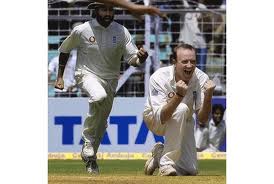
A gradual but inevitable descent into cricket-based loathing and bile.
Classic Series Review: India vs. England 2006
“I fell in to a burning ring of fire
I went down, down, down
and the flames went higher.
And it burns, burns, burns
the ring of fire
the ring of fire.”
Whenever England tour India, a set of rather unpleasant images are painted. Cricket anecdotes seem to be sprinkled with tales of shoddy aeronautical engineering and crammed trains taking players between cities, of rats in the shower and cockroaches in the bed and of terrible plumbing. That crazy Jack Russell, taking a suitcase of baked beans on tour! Fred Trueman describing, thankfully in little detail, not only Delhi belly but also the Madras splash, Bombay spray and Calcutta splutter! You know, occasionally, between trips to the loo, some cricket was played too.
I’ve never been to India, but I’d wager that the England stars of 2012 will be staying in some decent hotels – they might even have running water and somewhere to plug in the X-Box – and that even if some local cuisine is a tad harsh on the stomachs, there will be a cornucopia of alternatives to stop them either going hungry or feasting solely on Mini Cheddars and Bounty bars. However, irrespective of eating habits and toilet behaviour, the tour will no doubt be very difficult on the pitch – as it has been for at least 20 years. From the early 1980s onwards, an improving India and declining England meant the series – at least in subcontinental conditions – would generally have one outcome only. The nadir for England was 1992/93, a series we’d dearly love to write about but fear we’d break the internet such would be the vitriol that would pour out of our laptops.
As you might have heard, England won the Ashes in 2005. They followed this national triumph with a lacklustre 2-0 defeat in Pakistan, which culminated in the truly abject moment that was Liam Plunkett debuting for England. Three months later and England arrived back in Asia to battle India, who themselves had recently lost to Pakistan (it’s irrelevant to this article, but their defeat by 341 runs at Karachi happened despite Pakistan being 0/3 after the first over).
First Test, Nagpur
Believe it or not, there was once a time when Alastair Cook wasn’t batting for England. But for eternity – or at least his 21 and a bit years – he was earmarked as a future England batsman. After the sad return homewards of Marcus Trescothick, Cook flew from the West Indies to India and was handed his cap pretty much the moment he made it through duty free. An impressive 60 wasn’t a bad way to start, particularly as the side were also missing Michael Vaughan (and Simon Jones for that matter, and Ashley Giles). However the bulk of England’s first innings 393 came from Paul Collingwood, whose 134* – his first Test century – was a mixed bag, lasting almost six hours but also containing four sixes. Sreesanth, another debutant, did annoyingly well with the ball, taking four wickets.
In reply India made 323, thanks to the unsung trinity of Wasim Jaffer (81), Mohammad Kaif (91) and Anil Kumble (58). However the star of the innings was definitely Matthew Hoggard, whose 6/57 came from 30.5 long overs. Somehow England failed to throw away their advantage in their second knock, finding batting surprisingly easy; the declaration from captain Andrew Flintoff came with the score on 297/3, Pietersen having made 87 and one AN Cook sat there pristinely on 104*.
India’s target of 368 never looked on the cards and was even more unlikely once Virender Sehwag was bowled by Hoggard for a 13-ball duck. However the Indian batsmen were steadier this time around, with Rahul Dravid’s 71 and Jaffer’s 100 helping them to a draw. Not even Ian Blackwell’s mystery straight-uns could see England home. Despite Cook’s 164 runs, it was Hoggard who took the man of the match award.
Second Test, Mohali
After having been the better side in Nagpur, the old familiar problems of playing in Indian conditions came back to bite England in the second Test. For starters, Blackwell was dropped, but for Plunkett, a bit like finally overcoming a nagging cough, only to be kicked in the balls by a shire horse. Actually, things started okay: half centuries from Pietersen, Flintoff and Geraint Jones took England to 283/5 (across three days due to bad light and rain), but five quick wickets, including Kumble wrapping up both his Michelle and his 500th wicket in Tests, meant they were bowled out for a precise 300.
Despite a magnificent 9.2 overs (1/37) from Plunkett, England never let India really pull ahead: Dravid played a captain’s knock for 95 and plenty of lower order contributions secured a lead of just 38 runs; with a day and a half to go, a draw looked likely. The second innings though, was familiarly limp. Only Flintoff and Ian Bell made 50s, indeed no other batsman scored more than 14. Losing four wickets to Kumble isn’t embarrassing; losing four to Munaf Patel definitely is. Bowled out for 181, England presented India with just 144 to win. The target was reached in 33 overs, Sehwag unbeaten on 76 and Plunkett having conceded 22 runs from his brace of overs. A poor, poor defeat for the tourists, 1-0 down in the series and just the Wankhede Test to play.
Third Test, Mumbai
It was all change for England, with Plunkett dropped for Shaun Udal, James Anderson preferred to Steve Harmison and most worryingly of all, Cook ruled out with a stomach bug (he should have stuck to the Bountys). In his stead came the Middlesex man Owais Shah. England made a solid start, with Strauss making a fine 128 and Shah an equally fine 88 on debut. From 326/3 they ought to have scored more than 400 – but despite another 50 for Flintoff the tail collectively announced that “Tonight Matthew we’re going to be complete bunnies.”
Somehow though, India’s response never really gathered momentum. There were regular wickets, particularly for Anderson (4/40) in his first Test in more than a year. Arguably the key moment was when MS Dhoni, having hit Flintoff for three consecutive boundaries, attempted a Ponting-like single and was run out by Anderson for 64. India struggled to 279ao and England had a significant lead.
Then it began to unravel again. Ian Bell continued a pretty awful series for him by being caught behind for just eight. Both Strauss and Pietersen also fell cheaply. With the score on 88, Collingwood knocked the ball to third man, Shah called for a single and when the Dhoni removed the bails, the twitchy one was still jogging somewhere in the vicinity of Pune. A 32 from Collingwood and Flintoff’s fourth consecutive half-century did restore some pride to the innings, but when Anderson edged a Kumble googly to Dravid, they were all out for just 191. The lead was an admirable 312 runs, but with more than a day to go, all four results were possible. England needed to win to square the series, but India had the batsmen capable of not only seeing out a draw, but also chasing down the target. At stumps on the fourth evening, they were 18/1. Due to Sehwag’s back niggle, Irfan Pathan opened alongside Jaffer; with Kumble coming in as nightwatchman it was truly one of the oddest – and worst – top orders in Test cricket.
On the final day Flintoff was unplayable – Jaffer faced 23 balls from the captain and failed to score from any of them. His fall for 10 from 57 balls was the least unlikely event since 51allout failed to get off with a hot girl at the previous year’s Christmas party. At lunch though India were 75/3, with plenty of batting still to follow incumbents Dravid and Tendulkar. History doesn’t record what happened in the Indian dressing room at lunch, but in England’s the sound of Johnny Cash echoed. Ring of Fire isn’t the most likely team song in cricket, it must be said, but it clearly had some positive effects.
In the first over of the afternoon session, Dravid played forward to a slightly short Flintoff delivery, which cut and found the edge. The next over, Udal tossed and turned a ball that took the inside edge, rebounded off Tendulkar’s pad and into Bell’s hand.
Suddenly, India were 76/5. The fielders closed in, the home team vulnerable and afraid. Sehwag – unfit and overweight for once – lasted 16 scoreless balls before Anderson had him plumb LBW.
To Udal’s first ball of the 44th over, MS Dhoni charged forth and swung his bat: the ball landed somewhere near the hapless Panesar at long-off – a lucky escape for the last recognised batsman. Three balls later Dhoni repeated his blunder and this time Panesar pocketed the catch, to general disbelief. At 92/7, the match was all but over. Then Harbhajan Singh top-edged a sweep to Hoggard and Flintoff reversed a ball to Yuvraj Singh that Collingwood claimed easily in the slips. And finally Munaf Patel fell into the ring of Udal’s fire, swinging him into safe hands in the deep – Hoggard again: 100 all out. Udal – in his final Test – finished with an unlikely 4/14; Flintoff 3/14. By taking an incredible seven wickets in 15.2 overs, England had won by 212 runs, their first victory in India since 1985.
The series statistics were telling: none of Dhoni, Yuvraj, Sehwag or Tendulkar averaged more than 21.50 and Wasim Jaffer was the only Indian century-maker. Anil Kumble may have taken the most wickets in the series (16), but Hoggard’s 13 at 17.84 were arguably more valuable. For the time being Flintoff continued his heroics of 2004 and 2005 with 11 wickets and 264 runs. Finally, there was Udal. A veteran of county cricket but still an international novice, his winter in the sun secured his fifteen minutes of fame. Considering the series featured Blackwell, Plunkett and Shah as well as Udal, this drawn series ought to be remembered as one of the best England results of the Duncan Fletcher years.





No Comments
Post a Comment